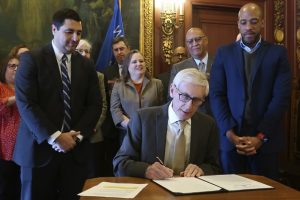Evers signs order setting up new redistricting commission (UPDATE)
By: Associated Press//January 27, 2020//
Evers signs order setting up new redistricting commission (UPDATE)
By: Associated Press//January 27, 2020//

By SCOTT BAUER
Associated Press
MADISON, Wis. (AP) — Gov. Tony Evers signed an executive order Monday setting up what he promised would be a nonpartisan commission to draw new legislative maps next year for the Legislature to consider, a step Republicans have rejected as a sham.
Even though lawmakers won’t be forced to vote on the maps the commission draws up, Evers, a Democrat, said he hopes they will be pushed to consider less partisan maps. At the very least, the commission will ensure there’s a more public process than what the state had in 2011 when Republicans met in secret to come up with the current maps, which were released with little time for public review before being passed.
“People should be able to choose their elected officials, not the other way around,” Evers said at a news conference in his Capitol office, where he was surrounded by Democrats, including Lt. Gov. Mandela Barnes and Attorney General Josh Kaul. “Certainly I would hope that they see the light and adopt our maps.”
The Wisconsin Constitution gives the Legislature authority to approve maps every 10 years and draw new boundaries for the state’s congressional and legislative districts. These sorts of maps are scheduled next to be drawn up in 2021, following this year’s census, which begins in April. Evers, as governor, can sign them into law or veto them. The executive order he signed on Monday does not change that process, but rather sets up a commission that will travel the state over the next year to gather advice before drawing up its own maps.
People of the state will be able to see and compare maps from the commission and the Legislature and then decide whether “there’s something wrong with this picture,” Evers said.
Republican legislative leaders have dismissed Evers’ plans for the commission. Assembly Speaker Robin Vos said it’s incomprehensible how anything that was set up and supported almost entirely by Democrats could be considered nonpartisan. Evers said again Monday that the commission will have no allegiance to any particular political party.
“We have 5.5 million people in the state of Wisconsin,” Evers said. “I think we can come up with a bunch who are nonpartisan.”
The commission will draw its members from all eight of the state’s congressional districts. The appointees are expected to be experts in nonpartisan redistricting. Elected officials, “public officials,” lobbyists and political party officials will be prohibited from serving.
The Legislature is now controlled by Republicans. The exact makeup of the Legislature that will vote on new maps in 2021 will be determined in November’s elections, but Republicans are expected to retain their majorities.
Among the respondents to a Marquette University Law School poll from January 2019, 72% said they support plans to have a nonpartisan commission draw up electoral maps. Only 18% thought the Legislature should devise the maps.
Republicans have rejected past attempts to amend the constitution to set up a nonpartisan redistricting process.
In 2011, the maps drawn by GOP lawmakers in Wisconsin’s state Legislature were challenged as being illegally gerrymandered to favor Republicans. The U.S. Supreme Court refused to hear the case but ruled in similar lawsuits last year that states are free to draw their electoral borders as they please, shutting down challenges in federal court.
An Associated Press analysis of the election results showed that Wisconsin’s districts had one of the largest Republican tilts in the nation. The “efficiency gap” analysis, which is intended to flag likely cases of gerrymandering, suggested that Democrats would have won at least one additional U.S. House seat and at least 15 additional state Assembly seats in 2018 if district lines had been drawn more fairly. That would have been enough to give Democrats control of the state Assembly and an even partisan split in the state’s congressional delegation.
Republicans hold five of the state’s eight congressional districts, have a 63-36 majority in the Assembly and a 19-14 majority in the Senate.
Legal News
- Amended complaint filed in federal court against State Bar of Wisconsin seeks punitive damages
- United Healthcare suit against cancer drug distributor time-barred
- Trump’s Wisconsin visit warns of jail time if he violates a trial gag order
- Dane County court overturns residential solar decision
- Judge faces formal complaint from state board
- Bankruptcies up 16% in U.S.
- (Updated) Wisconsin law enforcement clash with pro-Palestinian Madison protestors
- Gov. Evers seeks applicants for Lafayette County Circuit Court
- Complaint against University filed by Wisconsin law firm over $1.9M given to Palestinian students
- Hush money trial judge raises threat of jail as he finds Trump violated gag order, fines him $9K
- Active shooter ‘neutralized’ outside Wisconsin middle school
- Audit finds Wisconsin Capitol Police emergency response times up, calls for better tracking
WLJ People
- Power 30 Personal Injury Attorneys – Russell Nicolet
- Power 30 Personal Injury Attorneys – Benjamin Nicolet
- Power 30 Personal Injury Attorneys – Dustin T. Woehl
- Power 30 Personal Injury Attorneys – Katherine Metzger
- Power 30 Personal Injury Attorneys – Joseph Ryan
- Power 30 Personal Injury Attorneys – James M. Ryan
- Power 30 Personal Injury Attorneys – Dana Wachs
- Power 30 Personal Injury Attorneys – Mark L. Thomsen
- Power 30 Personal Injury Attorneys – Matthew Lein
- Power 30 Personal Injury Attorneys – Jeffrey A. Pitman
- Power 30 Personal Injury Attorneys – William Pemberton
- Power 30 Personal Injury Attorneys – Howard S. Sicula











